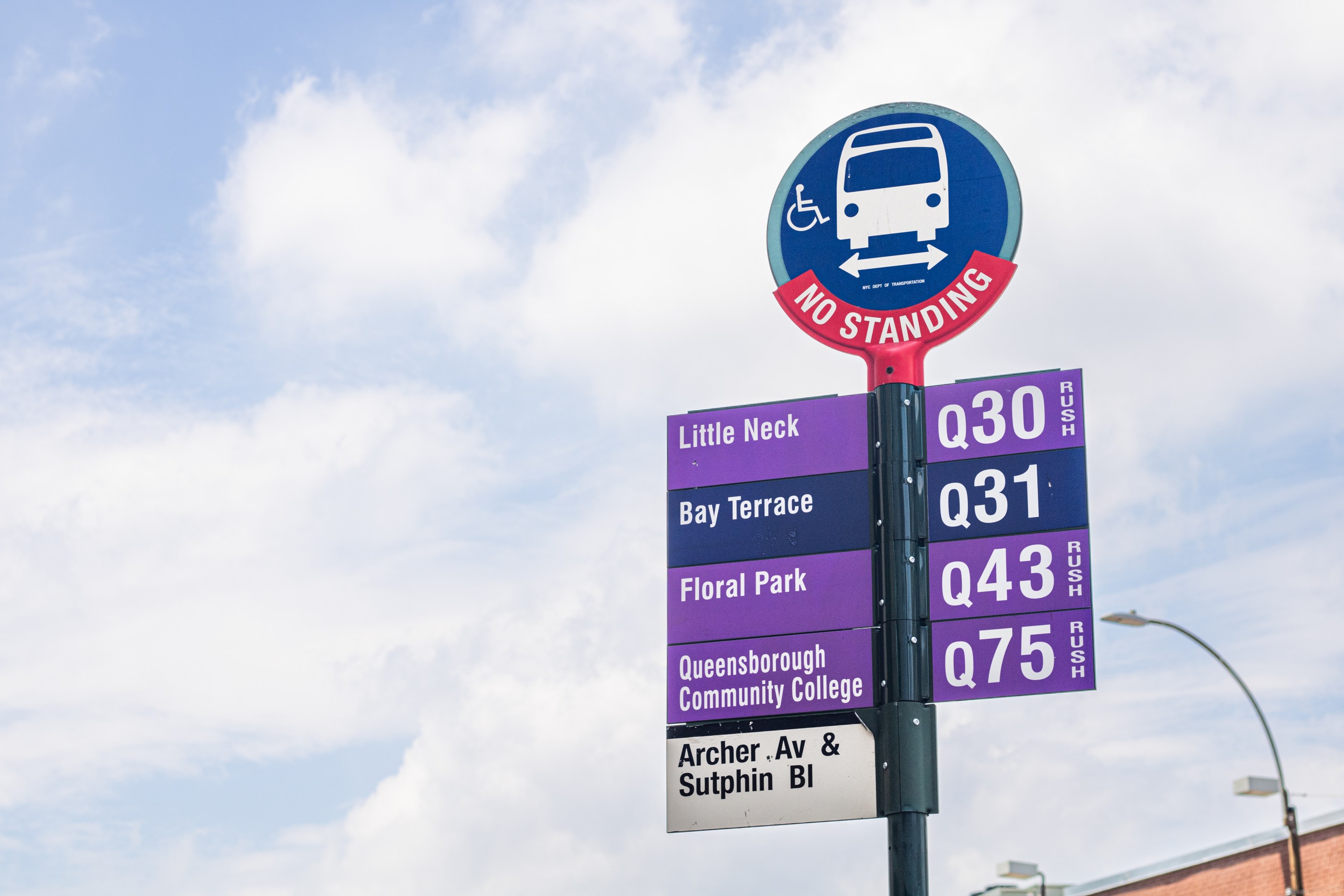Rockaway Freeway, a multi-lane divided road beneath the A train on the Rockaway peninsula, is hardly friendly territory for walking or biking. A group of teens interning with the Rockaway Waterfront Alliance is looking to change that. Their goal: Gather 10,000 signatures on a petition asking DOT to convert some under-used road space, created as part of a traffic-calming project years ago, into a safe place for walking and biking.
“There are two striped buffers that aren’t being used for anything," said Sebastian Rahman, 15, a sophomore at Scholars Academy in Rockaway Park and an intern with RWA. "People still do use them to get from point A to point B, even though it isn’t really isn’t safe."
“You have people speeding there," said intern Kaitlyn Kennedy, 16. “It’s not the safest place to be walking.” A road diet reduced the number of lanes and added the striped buffered areas more than a decade ago, but Rockaway Freeway continues to be a dangerous road: Last December, a teen driver killed one of his passengers and seriously injured another in a late-night crash on the road at Beach 41st Street.
"We saw the Rockaway Freeway as a great opportunity," Rahman said. After Hurricane Sandy wiped out portions of the boardwalk, he continued, "there was no more connectivity between the east side and the west side of the peninsula." Together, the student interns have come up with a concept that mixes new planted areas with more space for pedestrians and a dedicated bike path.
Although post-Sandy recovery brings new urgency to the idea, talk of improving Rockaway Freeway originated well before the hurricane struck. RWA launched a community visioning plan in 2011 to better understand what residents wanted for the peninsula. "People felt there was a disconnection between various parts of the Rockaways because there was no main drag," RWA executive director Jeanne DuPont said. Because the storm wiped out sections of the boardwalk and an effort to plan the Jamaica Bay Greenway route involved longer-term investments, RWA shifted its immediate focus to Rockaway Freeway. “We saw a lot of people using it, and the reason they were using it is because there was no other place to walk," DuPont said.
Last September, students participating in RWA's Shore Corps intern program began working on the project. The students created a video, launched a petition and began talking with people walking and biking along Rockaway Freeway. In February, the group made a presentation at the Youth Bike Summit in Manhattan to gather feedback on its effort.
"I thought going into the Youth Bike Summit that these people were going to be extremely bike crazy," said Jocelyn Dicent, 15. “I wasn’t sure how I'd feel about it." But after seeing how the Rockaway Freeway project fits into the larger picture of community-led environmental advocacy, Dicent came away energized. “It was actually a really amazing experience," she said, "learning about what everyone else is doing and realizing that we’re actually working on an issue that matters."
As the weather warms, the students continue to gather support online and along Rockaway Freeway. Rahman estimates that the group has more than 1,000 signatures by now, most of them on paper petitions. Boosted by coverage from DNAinfo and WCBS-TV, the group hopes to get the city's attention soon.
The students' proposal recommends repurposing some of the road's asphalt to create space for treating stormwater runoff. DuPont said she would like to apply for green infrastructure grants from the Department of Environmental Protection, but those funds are limited to areas with older sewer systems that mix with stormwater runoff, and the Rockaways do not qualify.
DOT has met with the alliance, and DuPont said the agency has been receptive to the idea so far. She's hoping the community support demonstrated by the students' project can help push the city to create a plan of its own. She'd also like to talk to the MTA about improving connections to the subway stations overhead, and says an improved Rockaway Freeway could provide residents with better access to EDC-funded ferry service that started serving Beach 108th Street after Hurricane Sandy.
While the project might take a while to complete, local residents will have a chance to get a taste of what the road might look like at a temporary demonstration next month. RWA is planning a one-day re-imagining of Rockaway Freeway at Beach 59th Street as part of its Earth Day celebration on May 3. "It’s going to be one of the ways we can show the community this is more than just a two-lane freeway," Rahman said.
“Most people seem really positive about this, that this is an important issue that needs attention," said Kennedy, who added that some Rockaway residents she's encountered don't believe the city will be interested. Kennedy said she isn't so sure about that. “You’ll never know until you try, basically.”





